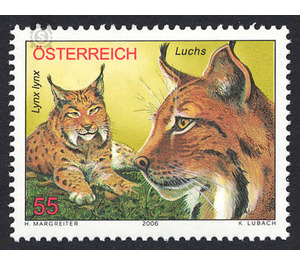fauna - Austria / II. Republic of Austria 2006 - 55 Euro Cent
Theme: Animals
| Country | Austria / II. Republic of Austria |
| Issue Date | 2006 |
| Face Value | 55.00 |
| Edition Issued | 700,000 |
| Printing Type | combination printing |
| Stamp Type | Commemorative |
| Item Type | Stamp |
| Chronological Issue Number | 1947 |
| Chronological Chapter | OOS-OE2 |
| SID | 524180 |
| In 53 Wishlists | |
The Eurasian Lynx (Lynx Lynx) was originally native to all forested areas of Central Europe. From the Spanish Pyrenees to the Asian region, from Scandinavia to Greece, its range was enough. While the lynx still roamed the Austrian forests in the 18th century, it was ruthlessly persecuted until the end of the 19th century as an annoying "predatory game" until extinction. Only in recent decades did lynxes migrate from the Bavarian Forest and the Bohemian Forest into the forests of the Mühlviertel and Waldviertel. However, in the Alps, as in the Gurktaler Alps and in the Karawanken of southern Carinthia, only a few animals have sufficient habitat. Resettlement projects have been favoring the native of this species since the 1970s. The Eurasian lynx is the heaviest member of the four lynx species. The male, also called Kuder, can weigh up to 25 kg and reach a height of up to 120 cm at a shoulder height of 50-70 cm. The females are a little smaller. The lynx features a reddish-brown to gray-beige fur with black spots, a round head, a pronounced whiskers and black hair tufts ("brush") on the ears. He has a short stubby tail with a black end bandage. The lynx lives as a loner in districts with an average of 150 km ², the size varies with the existing food supply. In a male district, two females often live. He mainly goes hunting at dusk and dawn, although the prey is active, and mainly snaps deer such as deer and chamois. He needs between one and three kilograms of meat per day. The lynx is a stalking hunter and attacks his prey ambush. If he fails, he does not pursue his victim. Larger distances the lynx lays in its territory mainly at night. The mating season (ranzzeit) of the lynx is from February to April. During this time, the lynxes are also observed during the day and make themselves felt by a characteristic "ma-uu" call. The wearing time is about 70 days. At the end of May, at the beginning of June, the pregnant female (cat) looks for the litter, usually there are two blind young, a sheltered place and does not leave it during the first weeks. She alone cares for the rearing. As long as the kittens can not follow the crack, they are nursed. After ten months, the young animals leave the mother and go in search of a suitable area. This is the most dangerous phase for the young lynx, most of them do not survive. The lynx has a closed season all year round in Austria and is still one of the endangered species.


